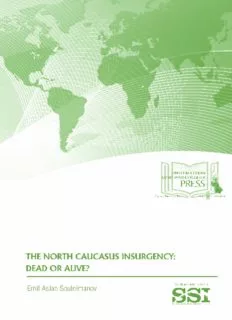
North Caucasus Insurgency: Dead or Alive? PDF
Preview North Caucasus Insurgency: Dead or Alive?
The United States Army War College The United States Army War College educates and develops leaders for service at the strategic level while advancing knowledge in the global application of Landpower. The purpose of the United States Army War College is to produce graduates who are skilled critical thinkers and complex problem solvers. Concurrently, it is our duty to the U.S. Army to also act as a “think factory” for commanders and civilian leaders at the strategic level worldwide and routinely engage in discourse and debate concerning the role of ground forces in achieving national security objectives. The Strategic Studies Institute publishes national security and strategic research and analysis to influence policy debate and bridge the gap between military and academia. The Center for Strategic Leadership contributes to the education of world class senior leaders, CSTERNATTEERG fIoCr develops expert knowledge, and provides solutions LEADERSHIP to strategic Army issues affecting the national U.S. ARMY WAR COLLEGE security community. The Peacekeeping and Stability Operations Institute provides subject matter expertise, technical review, and writing expertise to agencies that develop stability operations concepts and doctrines. The School of Strategic Landpower develops strategic leaders by providing a strong foundation of wisdom grounded in mastery of the profession of arms, and by serving as a crucible for educating future leaders in the analysis, evaluation, and refinement of professional expertise in war, strategy, operations, national security, resource management, and responsible command. The U.S. Army Heritage and Education Center acquires, conserves, and exhibits historical materials for use to support the U.S. Army, educate an international audience, and honor Soldiers—past and present. i STRATEGIC STUDIES INSTITUTE The Strategic Studies Institute (SSI) is part of the U.S. Army War College and is the strategic-level study agent for issues related to national security and military strategy with emphasis on geostrategic analysis. The mission of SSI is to use independent analysis to conduct strategic studies that develop policy recommendations on: • Strategy, planning, and policy for joint and combined employment of military forces; • Regional strategic appraisals; • The nature of land warfare; • Matters affecting the Army’s future; • The concepts, philosophy, and theory of strategy; and, • Other issues of importance to the leadership of the Army. Studies produced by civilian and military analysts concern topics having strategic implications for the Army, the Department of Defense, and the larger national security community. In addition to its studies, SSI publishes special reports on topics of special or immediate interest. These include edited proceedings of conferences and topically oriented roundtables, expanded trip reports, and quick-reaction responses to senior Army leaders. The Institute provides a valuable analytical capability within the Army to address strategic and other issues in support of Army participation in national security policy formulation. iii Strategic Studies Institute and U.S. Army War College Press THE NORTH CAUCASUS INSURGENCY: DEAD OR ALIVE? Emil Aslan Souleimanov February 2017 The views expressed in this report are those of the author and do not necessarily reflect the official policy or position of the Department of the Army, the Department of Defense, or the U.S. Government. Authors of Strategic Studies Institute (SSI) and U.S. Army War College (USAWC) Press publications enjoy full academic freedom, provided they do not disclose classified information, jeopardize operations security, or misrepresent official U.S. policy. Such academic freedom empowers them to offer new and sometimes controversial perspectives in the inter- est of furthering debate on key issues. This report is cleared for public release; distribution is unlimited. ***** This publication is subject to Title 17, United States Code, Sections 101 and 105. It is in the public domain and may not be copyrighted. v ***** Comments pertaining to this report are invited and should be forwarded to: Director, Strategic Studies Institute and U.S. Army War College Press, U.S. Army War College, 47 Ashburn Drive, Carlisle, PA 17013-5010. ***** All Strategic Studies Institute (SSI) and U.S. Army War College (USAWC) Press publications may be downloaded free of charge from the SSI website. Hard copies of certain reports may also be obtained free of charge while supplies last by placing an order on the SSI website. Check the website for availability. SSI publications may be quoted or reprinted in part or in full with permission and appropriate credit given to the U.S. Army Strategic Studies Institute and U.S. Army War College Press, U.S. Army War College, Carlisle, PA. Con- tact SSI by visiting our website at the following address: www.StrategicStudiesInstitute.army.mil. ***** The Strategic Studies Institute and U.S. Army War College Press publishes a monthly email newsletter to update the national security community on the research of our analysts, recent and forthcoming publications, and upcoming confer- ences sponsored by the Institute. Each newsletter also provides a strategic commentary by one of our research analysts. If you are interested in receiving this newsletter, please subscribe on the SSI website at www.StrategicStudiesInstitute.army.mil/newsletter. ISBN 1-58487-748-0 vi CONTENTS Foreword.......................................................................ix Preface . ..........................................................................xi Endnotes - Preface.......................................................xx About the Author.....................................................xxiii Summary....................................................................xxv The North Caucasus Insurgency: Dead or Alive? .............................................................1 I. Introducing the North Caucasus...........................9 II. Chechnya 2000–2010: A Model Counterinsurgency?............................................35 III. Counterinsurgency.............................................47 IV. Conclusion...........................................................71 Endnotes. ......................................................................77 vii
Description: